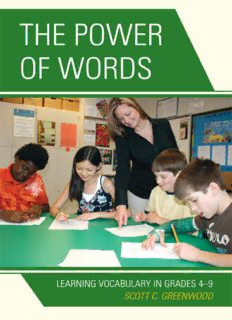
The Power of Words: Learning Vocabulary in Grades 4-9 PDF
Preview The Power of Words: Learning Vocabulary in Grades 4-9
The Power of Words Learning Vocabulary in Grades 4–9 Scott C. Greenwood ROWMAN & LITTLEFIELD EDUCATION A division of ROWMAN & LITTLEFIELD PUBLISHERS, INC. Lanham (cid:129) New York (cid:129) Toronto (cid:129) Plymouth, UK 1100__332222__0011__FFrroonntt..iinndddd ii 66//3300//1100 55::3388 AAMM Published by Rowman & Littlefield Education A division of Rowman & Littlefield Publishers, Inc. A wholly owned subsidiary of The Rowman & Littlefield Publishing Group, Inc. 4501 Forbes Boulevard, Suite 200, Lanham, Maryland 20706 http://www.rowmaneducation.com Estover Road, Plymouth PL6 7PY, United Kingdom Copyright © 2010 by Scott C. Greenwood All rights reserved. No part of this book may be reproduced in any form or by any electronic or mechanical means, including information storage and retrieval systems, without written permission from the publisher, except by a reviewer who may quote passages in a review. British Library Cataloguing in Publication Information Available Library of Congress Cataloging-in-Publication Data Greenwood, Scott C. The power of words : learning vocabulary in grades 4-9 / Scott C. Greenwood. p. cm. Includes bibliographical references and index. ISBN 978-1-60709-726-6 (cloth : alk. paper) — ISBN 978-1-60709-727-3 (pbk. : alk. paper) — ISBN 978-1-60709-728-0 (electronic) 1. Vocabulary—Study and teaching (Elementary) 2. Vocabulary—Study and teaching (Middle school) 3. Word recognition—Study and teaching (Elementary) 4. Word recognition—Study and teaching (Middle school) I. Title. LB1574.5.G738 2010 372.6'1—dc22 2010012722 (cid:2) ™ The paper used in this publication meets the minimum requirements of American National Standard for Information Sciences—Permanence of Paper for Printed Library Materials, ANSI/NISO Z39.48-1992. Printed in the United States of America 1100__332222__0011__FFrroonntt..iinndddd iiii 66//3300//1100 55::3388 AAMM Contents List of Figures v Acknowledgments vii 1 Why This Book? 1 2 What Works: Principles of Sound Vocabulary Instruction 15 3 What’s to Come: Indirect, Direct, General, and Specific Methodologies 31 4 Vocabulary and Narrative Text 39 5 Teaching Vocabulary in the Content Areas 71 6 Vocabulary and Writing 91 7 Structural Analysis and Word Parts 109 8 Using Dictionaries and Other Tools of Reference 125 9 Serendipity 137 10 The Assessment of Vocabulary, Including Test Preparation 161 Appendices 173 References 211 Index 217 About the Author 223 iii 1100__332222__0011__FFrroonntt..iinndddd iiiiii 66//3300//1100 55::3388 AAMM 1100__332222__0011__FFrroonntt..iinndddd iivv 66//3300//1100 55::3388 AAMM Figures 2.1 Word Card (decrepit) 16 2.2 Tomlinson Continuum 17 2.3 Student Autonomy Continuum 18 3.1 Overall Organizer 33 4.1 Strategies for Narrative Texts 42 4.2 Bookmark 47 4.3 Character Map (Simon) 59 4.4 Vocabulary Tree (vac) 60 4.5 Concept Circles 61 4.6 Concept Circles 62 4.7 Word Card (Tyron) 63 4.8 Word Card (obstreperous) 63 4.9 Word Map (therapist) 64 4.10 Knowledge Rating—1960s 66 5.1 Organizer for Chapter 5—Content Area Reading 73 5.2 Frayer Model (raptors) 77 5.3 Word Map (lance) 83 5.4 IT FITS (Morticia) 87 6.1 Strategies for Writing 93 6.2 Continuum of Word Knowledge 95 6.3 Specific to General Word Maps 99 6.4 Vocabulary Collection Frame 102 6.5 How Well Do I Know 103 7.1 Vocabulary Squares 122 7.2 Vocabulary Squares 123 v 1100__332222__0011__FFrroonntt..iinndddd vv 66//3300//1100 55::3388 AAMM vi Figures 8.1 Concept of Definition Map (feline) 129 8.2 Basic Word Map (elated) 129 8.3 PAVE 133 9.1 Word Map (word blends) 145 10.1 Word Map (rainforest) 169 1100__332222__0011__FFrroonntt..iinndddd vvii 66//3300//1100 55::3388 AAMM Acknowledgments I am deeply indebted to many fine professionals who provided all kinds of support as I struggled with Parkinson’s disease, making a challenging job even more difficult than I bargained for. Tom Koerner, my editor at Rowman & Littlefield, is a delight to work for/ with. He is a stickler, a realist, and a man who clearly knows his stuff! Ad- ditionally, I am deeply grateful to Melissa McNitt, my production editor, for crossing the Ts and dotting the Is and bringing this book to fruition. Dr. Patrick McCabe of St. John’s University copyedited with diligence. Dr. Sharon Kletzien, professor emeritus and my former department chair at West Chester University, also lent her substantial editorial skills. She was somehow simultaneously brutally honest and encouraging. Maureen Cook, a former graduate student at West Chester University, lent the invaluable perspective of a new teacher and potential reader. Gina Evangelista, a West Chester University graduate student, gave sub- stantive support throughout the entire process, particularly during the late (aka tedious, detail-filled) phases of getting the manuscript out the door. vii 1100__332222__0011__FFrroonntt..iinndddd vviiii 66//3300//1100 55::3388 AAMM 1100__332222__0011__FFrroonntt..iinndddd vviiiiii 66//3300//1100 55::3388 AAMM Chapter One Why This Book? We are made to persist. That is how we find out who we are. —Tobias Wolff BACK-TO-SCHOOL NIGHT, FALL 2009 I am reminded of my own mortality as I record anecdotes about the literacy learning of my two sons, Nathaniel and Alex. I had them late in life, and I used to joke about how they’d be sending me off to the old folks’ home at about the same time they’d be going off to college. My other one-liner regarded diapers: now I’m putting them on the boys; soon they’ll be putting them on me. I am also reminded of how long it is taking me to write this book! Now my boys are 12 and 10 years of age, which fits nicely with the middle level scope. Anyhow, regarding Back-to-School Night. The local school district is fairly large (thirteen thousand–plus students) and fast paced (over 90 percent of the high school graduates go on to four-year colleges). I dutifully follow the abbreviated schedule for my twelve-year-old. I at- tend Nathaniel’s writing course, which is separated from his reading course. I believe that reading and writing are inseparable, but I don’t want to come off as a complaining parent. What really, really troubles me, though, is “the list” of vocabulary words that are assigned on Mon- days for the Friday tests. The teacher notes (proudly) that the students are supposed to use their new words in grammatically correct sentences every week. “I saw the aardvark” is grammatically correct, but it 1 1100__332222__0022__CChh0011..iinndddd 11 66//2299//1100 1111::4444 AAMM
Description: